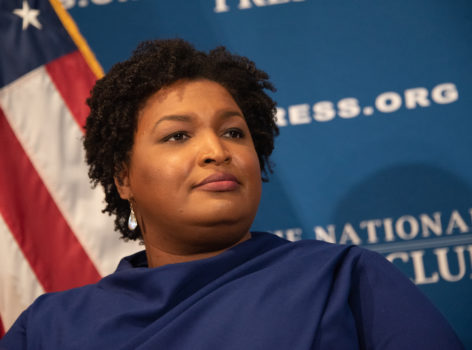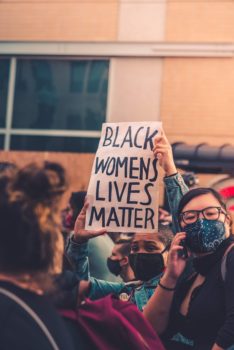
Stacy Abrams
I love being a Black woman. I am awed by how powerful Black woman are and how unspeakably overlooked we have been because of it—consider Stacey Abrams and Keisha Lance Bottoms. Whether you agree with their politics or not, they have shown us that leading humans to and through change requires emergent thinking, creativity leaps and a loving ability to envision a more democratized future. They personify Afrofuturism. They watched the beautiful multiplicity of their Georgia communities becoming more politically engaged. They continuously strategized, as servant leaders, by embracing that emergence as positive change. I relate to them. They are curious enough about the communities they serve to lead with rigor and intuition, leaving the world to improvise with results many of us may (not) have seen coming.
As education leaders, we must lead the team we have through a world of change we don’t choose, as opposed to the change we might be able to control. It is time for us to have a more constructive relationship with change.
****
It appears we’ve stopped imagining how to best support our teams. Far too often, we rely more on proclamations of passion than overt curiosity balanced with rigor to tell us who among us is really capable and committed to guiding our communities through the imperatives of change. We often rely on leadership books and toolkits that are full of contrived buzzwords and unrelatable jargon. Unfortunately, these books are often conceived and written by populations of scholars, thinkers or practitioners that do not reflect the diversity of the communities we lead inside our organizations, nor the communities we serve.

Photo by Max Bender on Unsplash.
That blind enthusiasm then becomes the primary guide for our disposition to be self-righteous. Our behavior often reflects our attitude that being passionate is what matters the most. In doing so, we erode our own curiosity and diminish our capacity to be rigorous. We overlook in-depth, diverse perspectives, and our leadership tactics become stagnant, soggy, saturated because passion (though often subjective and arbitrary) becomes the baseline of how we view ourselves and those sitting next to us.
We also overlook the obvious: What we have learned about how to lead has been largely taught to us through brilliant books, seminal work and theoretical constructs mostly authored by white people in education and business—the sources revered as tried-and-true. As servant leaders, we have the best of intentions but given that we’re applying the same lens to affect change, is it any wonder we continue to have the same difficulties learning to lead through change?
Maybe our self-righteousness doesn’t allow us to buy into anything different.
What I know for sure is that education needs to be rebuilt from the heart up.
To our credit, many of us as leaders are not completely out-of-touch. Many of us are still imaginative, insofar as recognizing that education needs to be rebuilt. We keep being imaginative, insofar as knowing that education needs to be rebuilt from the heart up. We imagine how we can play a role in a seemingly insurmountable change. But our rogue enthusiasm and ever-increasing self-righteousness lend themselves to one fundamental question: Are we really thinking differently?
****
As servant leaders, it is fair to assert that a desire to be a part of a solution is a natural disposition for us. With that said, are we unable to make the connection that the natural world offers queues of what change really looks like, how it occurs, why it occurs and how to water it?
Can we push aside our self-righteousness long enough to nurture nature?
We need a new paradigm of servant leadership—a paradigm that encourages us to consider the principles of nature and respects our inherent capacities as humans.
For me, a journey through audiobooks over the past year has led me to see very clearly what we can learn from revisiting nature and applying it in similar ways to that of successful social justice warriors and futurist design thinkers. Higher education could stand to lovingly plagiarize some ideas that spread the intellect, beauty, brilliance and power of Black women who celebrate using and magnifying what’s inherent and natural.
****
Adrienne Maree Brown is a cultural facilitator who encourages us to have a more constructive relationship with the reality of change inside and across communities. The real beauty of this, known as emergent strategy, lies in the direct and simple principles upon which it is grounded, one of which is fractal thinking. Fractal thinking means cherishing the relationship between the small and the large. Fractals are never-ending, infinitely complex and self-similar like a repetitious feedback loop. Like the form and shape of plants, their process of mirroring (fractal) patterns of nature pays deliberate attention to the multiplicity of small acts, the respective connections between them and how they spark complex systems that create change.
It makes sense that our work is to respect change—the inherent love and joy is in the multiplicity that brings about change even if we are conflicted about the change itself. It makes sense to question our relationship to change and accept that we may not be living with it in a healthy way. It makes sense that change is not an enemy to be conquered or deliberately avoided. As leaders, we’ve been told, and often teach, that change is purely an action and not a naturally beautiful state of being.
Are we avoiding the obvious and ultimately leaping over our own creativity?
****
Just as we all have the ability to use fractal thinking, we all have the inherent ability to access our own creativity. Natalie Nixon is a creativity strategist and design thinker in the Afrofuturist space who reframes creativity in a way that humanizes it—she puts it within reach for each of us by reminding us that creativity is natural. It’s not a foreign body that lies outside of us.
Our creativity lies in the beautiful blend of our own inquiry, intuition and improvisation as we glide back and forth between our wondrous curiosity and rigorous skill. As leaders, let’s remember that those we lead are abundantly capable of being creative. We can facilitate this leap toward greater possibilities by taking a leap away from the myth that creativity is anything other than highly present in every fractal communal space. Creativity is a democracy, not a monopoly; it’s something innate. It is how we all exist, and our access point is the same—(human) nature.
As leaders, if our goal is to lead healthy, creative teams and communities of educators that move equity forward in higher education, we need to draw from paradigms that honor that. We need to listen more and talk less. We need to move away from feeling and believing we somehow need to empower those we lead and that we are fundamentally capable of empowering those we lead. We need to move toward being blatantly respectful of people and the spaces they hold, as they are fractal elements of a large, complex system. Why are we so convinced they don’t recognize their own power?
We are distracted!
We’ve been paying too much attention to the wrong things! With extremely great intentions, we’ve been laser-focused on the concepts of innovation, ecosystems and creativity in education, coveting them as though they are unique, external concepts or circumstances. They are not! These terms have become diluted, disingenuous and have become the goal instead of the means by which we achieve the goals. I am not sure that any one of us really understands what they mean, or intend to mean, anymore; I often question if we ever really did.
****
Specifically, we’ve become a bit obsessed with ideas like those of learning ecosystems (or perhaps our contrived notions of what they are) instead of lovingly respecting them. Ecosystems do not scale; they grow naturally, not through force. Distinct parts within an ecosystem love and respect each other equally as necessary and vital, where no one piece is more singularly important than any other. We seem to miss the point that scalable models are not always useful and are not typically attainable, particularly in the long run. We force scaling assuming that it will always be possible. Ecosystems of any sort are never the same—they’re not supposed to be. No two ecosystems are or will ever be the same, nor will any of their parts. What do they have in common is balance, when they’re true.
We’re dismissing our own creativity by trying too hard to be creative.
It’s clear that what we do pay attention to will grow exponentially. There is no debate about that. Let’s choose to pay attention to the individuals we lead, building a community of contributors and leaders, supporting the beautiful multiplicity that naturally emerges. Mindful, fractal thinking echoes love of the natural human self and magnifies the very truth that our creativity is inborn. Loving who we lead and respecting what they bring more than what they’re trying to build breeds reciprocity and multiplicity—that, in itself, builds its own ecosystem. Our ability to love is natural, fractal and teaches us to manage the situation we have, not the situation we want, knowing that it will always change. That really is the beautiful truth.
It’s not beautiful to battle complexity with complexity. As educational spaces, we’ve chosen to respond to the world by becoming more complex. We’ve chosen to match the intensity of complex chaos instead of striking balance with it. That doesn’t work. We need to reflect upon our own complexity, seeking to simplify.
****
Nature is patient and reflective in ways we are often not. Let’s not forget the reality is that we are, after all, human beings—fractal cells that multiply into flesh and blood. Why is this not evident to us? Why do we miss the fact that we literally embody the micro-level natural elements that enable us to succeed, serve and lead? As humans first and educational leaders thereafter, we have the ability (and responsibility) to consider what we’re ingesting—what do you want on your bookcase, audiobook or podcast queue? Those sources that really magnify (human) nature or those that ignore it?
Will you rely on nature as the spark inside your imagination that creates more opportunities to really right your relationship with change? What would a Black woman do?
Keisha Venson Sheedy is an associate project manager with Southern New Hampshire University, supporting initiatives that reflect the university’s commitment to driving equity and access in education. Her career in higher education has spanned more than 15 years. She previously worked in diverse roles at Plymouth State University, Granite State College, DePaul University and Columbia College Chicago. She recently completed a Certificate in Creative Placemaking at the Institute of Art and Design at New England College, with particular focus on equity-based cultural arts projects related to the evolving demographic identity of New Hampshire. In 2020, she delivered the keynote address for the Northeast Popular Culture Association Conference, “What’s Popular? Myths, BS, Nonsense and Everything but LOVE!”
Related Posts:
“What Have You Done for Me Lately?” Looting, Love and Lifelong Learning
Reframing the Humanities: COVID-19 May Flip the Script on Overshadowed Human Experiences
[ssba]
